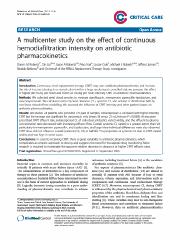Please use this identifier to cite or link to this item:
https://ahro.austin.org.au/austinjspui/handle/1/12743| Title: | A multicenter study on the effect of continuous hemodiafiltration intensity on antibiotic pharmacokinetics. | Austin Authors: | Roberts, Darren M;Liu, Xin;Roberts, Jason A;Nair, Priya;Cole, Louise;Roberts, Michael S;Lipman, Jeffrey;Bellomo, Rinaldo | Institutional Author: | RENAL Replacement Therapy Study Investigators | Affiliation: | Intensive Care Unit, St Vincent's Hospital, Victoria Street, Darlinghurst, NSW, 2010, Australia Burns Trauma and Critical Care Research Centre, The University of Queensland, Level 3 Ned Hanlon Building, Royal Brisbane and Women's Hospital, Butterfield Street, Brisbane, Queensland, 4029, Australia Intensive Care Unit, Nepean Hospital, Derby Street, Kingswood, NSW, 2747, Australia Department of Intensive Care, Austin Health, Heidelberg, Victoria, Australia Therapeutics Research Centre, School of Medicine, University of Queensland, Princess Alexandra Hospital, Ipswich Road, Brisbane, Queensland, 4102, Australia |
Issue Date: | 13-Mar-2015 | Publication information: | Critical Care 2015; 19(): 84 | Abstract: | Continuous renal replacement therapy (CRRT) may alter antibiotic pharmacokinetics and increase the risk of incorrect dosing. In a nested cohort within a large randomized controlled trial, we assessed the effect of higher (40 mL/kg per hour) and lower (25 mL/kg per hour) intensity CRRT on antibiotic pharmacokinetics.We collected serial blood samples to measure ciprofloxacin, meropenem, piperacillin-tazobactam, and vancomycin levels. We calculated extracorporeal clearance (CL), systemic CL, and volume of distribution (Vd) by non-linear mixed-effects modelling. We assessed the influence of CRRT intensity and other patient factors on antibiotic pharmacokinetics.We studied 24 patients who provided 179 pairs of samples. Extracorporeal CL increased with higher-intensity CRRT but the increase was significant for vancomycin only (mean 28 versus 22 mL/minute; P = 0.0003). At any given prescribed CRRT effluent rate, extracorporeal CL of individual antibiotics varied widely, and the effluent-to-plasma concentration ratio decreased with increasing effluent flow. Overall, systemic CL varied to a greater extent than Vd, particularly for meropenem, piperacillin, and tazobactam, and large intra-individual differences were also observed. CRRT dose did not influence overall (systemic) CL, Vd, or half-life. The proportion of systemic CL due to CRRT varied widely and was high in some cases.In patients receiving CRRT, there is great variability in antibiotic pharmacokinetics, which complicates an empiric approach to dosing and suggests the need for therapeutic drug monitoring. More research is required to investigate the apparent relative decrease in clearance at higher CRRT effluent rates.ClinicalTrials.gov NCT00221013 . Registered 14 September 2005. | Gov't Doc #: | 25881576 | URI: | https://ahro.austin.org.au/austinjspui/handle/1/12743 | DOI: | 10.1186/s13054-015-0818-8 | Journal: | Critical Care | URL: | https://pubmed.ncbi.nlm.nih.gov/25881576 | Type: | Journal Article |
| Appears in Collections: | Journal articles |
Files in This Item:
| File | Description | Size | Format | |
|---|---|---|---|---|
| 25881576.pdf | 1.38 MB | Adobe PDF |  View/Open |
Page view(s)
128
checked on Apr 2, 2025
Download(s)
122
checked on Apr 2, 2025
Google ScholarTM
Check
Items in AHRO are protected by copyright, with all rights reserved, unless otherwise indicated.
